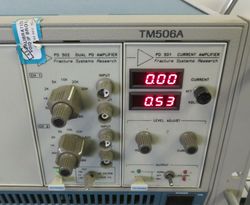Fracture Systems Research PD 501: Difference between revisions
Jump to navigation
Jump to search
(Created page with "<gallery> Fracture systems research pd 502 pd 501.jpg|Fracture Systems Research PD 501 and PD 501 </gallery> Category:Fracture Systems Research Products") |
No edit summary |
||
| (4 intermediate revisions by the same user not shown) | |||
| Line 1: | Line 1: | ||
{{TM500 | mfg=Fracture Systems Research | type=PD 501 | function=dual potential drop amplifier | class=amplifier | image=Fracture systems research pd 502 pd 501.jpg | introduced=(?)| discontinued=(?) | | |||
designers= |manuals= | |||
* ''please add'' [[Category:Manual needed]] | |||
}} | |||
The potential drop technique is used in materials testing. It works by passing a constant current through a specimen, and measuring the voltage generated across an area (usually the crack site). Both AC and DC implementations exist. | |||
{{MissingSpecs}} | |||
==Pictures== | |||
<gallery> | <gallery> | ||
Fracture systems research pd 502 pd 501.jpg|Fracture Systems Research PD 501 and PD 501 | Fracture systems research pd 502 pd 501.jpg|Fracture Systems Research PD 501 and PD 501 | ||
</gallery> | </gallery> | ||
[[Category:Fracture Systems Research | ==Manufacturer== | ||
[[Fracture Systems Research]] | |||
[[Category:Fracture Systems Research products]] | |||
Latest revision as of 22:59, 19 April 2022
The Fracture Systems Research PD 501 is a dual potential drop amplifier plug-in for the TM500 system.
The potential drop technique is used in materials testing. It works by passing a constant current through a specimen, and measuring the voltage generated across an area (usually the crack site). Both AC and DC implementations exist.
Key Specifications
- please add
Pictures
-
Fracture Systems Research PD 501 and PD 501

